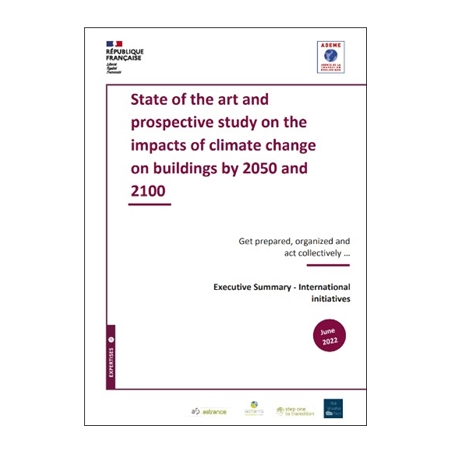In the context of the fight against climate change, there are already many regulations encouraging the implementation of greenhouse gas mitigation measures in the building and construction sector. However, the first part of the IPCC's sixth report "The Physical Science Basis", published in August 2021, is clear: climate change is a reality and, while mitigation actions must be continued, adaptation is now a necessity. Furthermore, the second part of the IPCC's sixth report, published in February 2022 "Impacts, Adaptation and Vulnerability", insists on the fact that climate change is negatively impacting all human systems in a global manner, although with regional disparities.
The perimeter considered for this study concerns metropolitan France and the overseas territories and includes a benchmark of public adaptation policies in four countries. Due to the disparity of the contexts, different impacts can be observed at the local level, requiring different responses. Given the rapidity of climate change and the associated hazards, adaptation to climate change represents the major challenge for the building and construction sector in the coming years. Indeed, extreme weather events will intensify, including in a world of +1.5°C, and, in order to limit the impacts of the various hazards (heat waves, floods, storms, etc.) on the built environment, it is essential to adapt both buildings and their uses to these changes.
Many actors in the building and construction sector are concerned by these issues, "from production to renovation", over the entire life cycle of the building. Nevertheless, the process of adaptation in the building and construction sector is still in its beginnings and "almost no adaptation strategy [has] been formulated before 2018" according to the French Green Building Observatory (OID). The challenge is to mobilise the appropriate levers in order to encourage this process and to launch cooperation between the various players in the sector in order to initiate a systemic adaptation approach for buildings. It is in this sense that the new European Union strategy on climate change "Forging a climate-resilient Europe", presented by the European Commission on 24 February 2021, was drafted. This strategy aims to move towards action on adaptation: to improve knowledge of adaptation solutions, to strengthen planning and deployment, and to improve resilience to climate change on a European scale. One of the objectives is to reduce climate risks and make buildings more resilient to the impacts of climate change. The aim is to integrate climate resilience into the construction and renovation standards for buildings and critical infrastructure. In a similar way, the Global Alliance for Buildings and Construction published in November 2021, at COP26 in Glasgow, the 10 principles for effective action for adaptation in the building and construction sector after having published a call for action a few months earlier, to enroll all actors of the building and construction sector into adaptation to climate change.
This executive summary focuses on the international best practices and the French know-how that could be disseminated internationally.
In the complete study in French, can be found :
- A part detailling the current and future impacts of climate change on buildings and their occupants.
- A part examining the solutions that can be put in place to adapt to the consequences of climate change, notably by drawing on foreign examples.
- A part carried out through collective intelligence workshops, analysing which roadmap Ademe can adopt in order to remove the barriers to adaptation and contribute to accelerating the deployment of the solutions identified.
